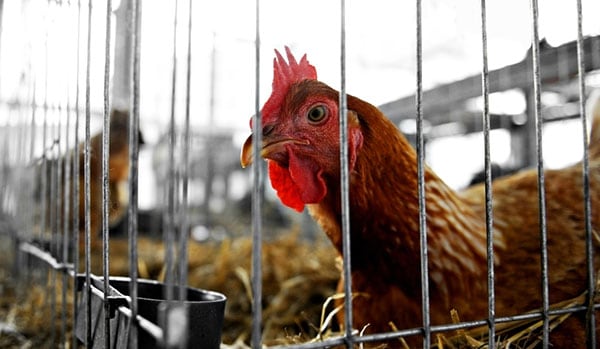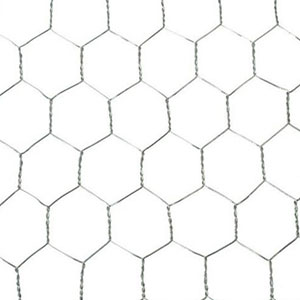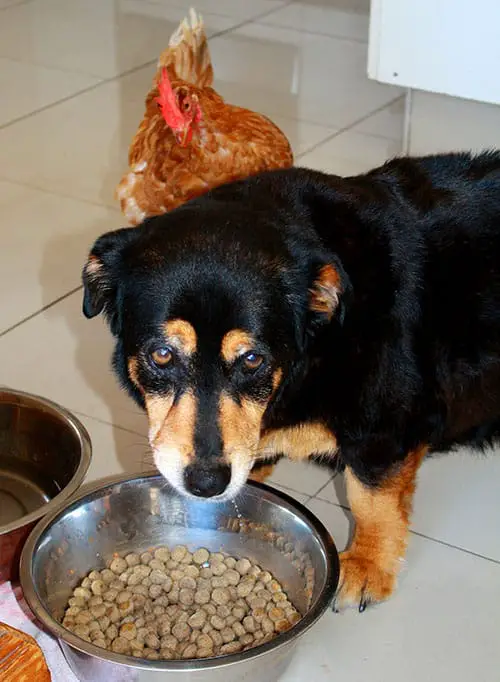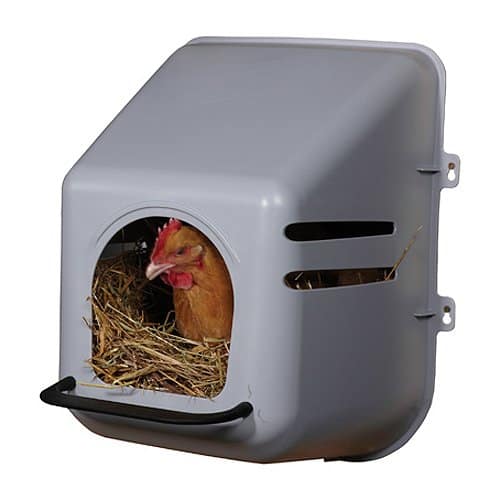The Ultimate Buyers Guide to Chicken Cages for the Suburbs (and Hobby Farms)

Quick Navigation
Whether you're looking for a top of the line chicken cage, or something that is simplistic yet functional, there are many new things to learn about what makes a good chicken cage.
What is a Chicken Cage Anyway?
To start with, let's examine the difference between a coop and a cage. Many of the chicken coops are made from soft timbers which do not stand up to harsh weather or time very well.
My idea of a cage is made from metal. Why?
Metal cages are designed to stand the test of time while tending to be much more rugged, tough and durable. Thus offering your chickens much more protection from the elements and predators than a wooden coop.
What To Look For In A Chicken Cage
Keeping your chickens safe from harm and providing them a warm and dry environment is the first thing that should be considered when you're considering a chicken cage. Other things to consider are whether or not you're going to have a mobile cage that can be moved around your yard or property, or if you're going to use a stable cage that isn't moveable.
Whichever route you select will be dependent upon a few factors. Your space (do you have the room to have a movable cage?) and your ability to move a moveable cage yourself (some require two or more persons to move them about the property).
Let's take a moment and examine the pros and cons of mobile vs immobile cages.
Mobile Cages - Pros vs Cons
Pros
- If you're using a mobile cage you can move it about your yard and garden thus offering fertilizer to various areas of your yard as needed.
- You can take advantage of exposure to the sun and prevent the chickens from having to be out in an area that may receive a lot of the wind or even rain.
Cons
- If there are weather related issues such as too much wind or rain you'll have to build a cover or wind brace for the cage.
- Size limited - You can only build a movable cage so big
- Can be less secure and more prone to predator attacks
Immobile Cages - Pros vs Cons
Pros
- If you're using a mobile cage you can move it about your yard and garden thus offering fertilizer to various areas of your yard as needed.
- You can take advantage of exposure to the sun and prevent the chickens from having to be out in an area that may receive a lot of the wind or even rain.
- Tend to be more secure (you can even build it above ground to stop predators digging to get in)
Cons
- You'll have to clean out your chicken cage more frequently and then turn your chicken manure and used bedding into compost.
- You'll need an area to store your used bedding and manure while it's turned into compost.
- You're stuck with the cage where it's built.
So What Should You Choose?
If you're in a more rural area with more space you're much more likely to want the stable, immovable type of cage that you can set up easily somewhere on your property. This can be a very small cage to a large cage that rivals the size of a small bedroom. It's all up to you and how many chickens you plan to keep.
Smaller blocks tend to be more suited toward a movable cage. Predators are less of an issue in suburbs and having a movable cage is great for your lawn and doesn't take up a large section of your yard.
If you are selecting a movable cage to be sure that it's all set up so that you can see what it will look like after you put it together. You'll want to see the type of construction as well as the type of materials that it's constructed from.
Can I still be free range if I have a stationary chicken cage?

Even if you have an immovable structure, you can still allow your chickens to free-range by simply opening the pen up during the day. Chickens that are free range will enjoy dining on bugs, grasses, plants, seeds (from weeds and the like) and whatever else they may find in and about the property.
This benefits your property in a myriad of ways so it is something that is important to consider prior to beginning construction on your chicken cage.
Special Notes On Free Range Chickens
If you're planning to free range your chickens you can use either of the above-mentioned methods. You'll want to keep your chickens penned up for a few days so that they know where “home” is and then you can allow them out during the day to range about the property picking at bugs and the like.
What Size Chicken Cage Do I need?
On average, you'll need to have 3 to 4 square feet per chicken that you have in your flock.
If you have smaller bantam sized chickens you can get away with 2 to 3 square feet per chicken.
You'll need to plan out their roosts and nesting boxes so that each chicken feels that they have enough space. Typically, you'll need at least one nesting box per 3 chickens so take that into account when you're planning out your chicken cage.
How Much Yard Space Do I Need?
When considering who is buying a chicken cage the farm life often comes to mind, however, as more cities are allowing their residents to raise hens more urban dwellers than ever before are buying and building chicken cages.
If you are located in the suburbs, it's important for to check with your specific city for any specific ordinances regarding raising chickens in town. Many have a limit on the number of chickens (usually from three to six per residence) allowed and typically none will allow a rooster to reside within city limits
The Different Features And Security Measures Of Chicken Cages
Choosing Your Net Or Wire
The wire on the chicken cage can help to keep the chickens in the chicken cage, however, if it's not of a strong enough gauge it may not keep out the fox or the dog that is intent on a nice chicken dinner. So it's imperative to ensure that the gauge of the chicken wire is of such a strength to protect the chickens from such predators.
You'll have many options when it comes to net or wire. Here are some of the options you'll have to make decisions from:
Galvanized Hardware Cloth

For a 24 inch by 50 foot roll (1/2 inch) joins you can expect to pay approx $40. Available here
Galvanized hardware cloth is an ideal choice for enclosing a chicken cage. You'll want this to be at least ½ inch or 19 gauge. The smaller openings may be more brittle and break easily. However, keep in mind that larger openings may allow predators in such as rats or snakes.
Hardware cloth is available in 3, 4, 5 and even 6-foot rolls. Typically, chicken owners choose those that are three to four feet and these will be anywhere from 5, 25, 50 or 100 feet in length.
It is recommended that you not use a power staple gun on this as it tends to not be as strong. Chickens may peck at these. Always opt for a pneumatic staple gun made for this purpose.

Chicken Netting is approx $15-$20 for a roll. Sizes Vary from 2-3 foot tall by 50 foot long. Available Here.
Chicken Wire
Perhaps due to the name, most people choose chicken wire for their cages. With thin hexagonal openings made of wire that is woven together, this is fairly inexpensive, but it will rust very easily. Sadly, it won't protect your chickens from raccoons nor will it protect from other predator
It's fine for a daytime cage that you don't have to be concerned about predators in, however, at night, it won't be very secure. Many people choose to use chicken wire only on the upper sections of their coops in order to save a few dollars. However, rodents and raccoons don't mind climbing for a nice chicken dinner.

Chain Link Fence - We found a great resource for putting one up here
Chain Link
Chain link fencing is strong and fairly easy to purchase. Chickens will be kept in and the dog may stay out, however, a sneaky raccoon who is determined to dine on your chickens won't be deterred.
It can cause some chaos and a bit too much excitement for the rest of the chickens or for children to see a baby chick snatched away and eaten. Always ensure that the chickens can retreat to a safe zone within such a cage.
Installing chain link fencing does require some building knowledge (mostly around putting in posts square). Many people get them put in professionally, but you can get what you need from hardware stores like lowes and home depot.
Rabbit Wire Fence
Heavy gauge wire fencing that is welded with 3 to 4-inch squares or rectangular openings will help to provide an additional measure of security to your chicken cage. You can attach it to the floor to give your cage more security. It will prevent predators from tunneling under and allow the chickens to scratch and graze while offering up some protection.

This rabbit wire fence has reinforcement at the bottom where it is most likely needed. See this and more rabbit wire fence types here.
It works more in the daytime and you'll want to ensure that there is additional security for the pen at night. You can overlap them or choose a smaller mesh in order to prevent visits from predators.
A typical 28 inch by 50 foot roll will cost you around $30 to $50.
Electric Wire, Do You Need it?
Electric fencing may also be used to add an extra level of protection to the chicken cage. Wild animals such as raccoons and other predators may be dissuaded from pestering and snitching chickens by an electric fence.
Many farmers choose electric fencing and create a wide perimeter in order to allow for some free range without having to worry about predators. By utilizing portable power sources, they can make it as large or as small as desired and keep their chickens safe.


When installing an electric fence you will also need to purchase a charger which plugs into an wall outlet - view a range of fence and chargers here.
There is also electric poultry netting that may be purchased if you're residing in an area where hawks or other large predator birds may pose a potential threat to the livelihood of raising chickens.
Tips for Dealing with Predators
Chicken cages are being used to help protect chickens from both the elements and other animals that may bother the chickens such as foxes and dogs.

A sensor light such as this one can deter predators and alert you when there is a cause for concern. More detail here
While many can train a dog to leave the chickens alone, there are times that dogs get the taste of blood and must be kept separated from the chickens for the safety of both the chickens and the dogs (neighboring chicken raisers tend to frown on a neighbor dog that attacks chickens and it's important to keep the neighbor's happy as well).
Seal all of the openings that are more than an inch with hardware cloth, you'd be surprised at how a large sized rodent or predator can squeeze through such a small opening and help themselves to a free chicken dinner.
When sealing openings, be sure to use screws as nails and staples can be manipulated and maneuvered aside to gain easy access.
Lastly, it's recommended that chicken cage owners attach a ½ inch hardware cloth to all of the open sides of the cage and then enclose it in a run to ensure their safety at night. Be sure to consider the top side of the cage and if it's open cover it with something to protect them from climbing predators.
It's important to remember that the cage is only as strong as the owner makes it so be sure to consider all of the possible predators that are relative to the specific area. Cover the exposed areas accordingly to protect your chickens.

Dogs can protect chickens from other predators, but must be trained properly
Extra Security for Your Chickens
Often a dog can be trained to chase away other potential predators to the chickens. It's usually best to select a dog breed that is easily trainable for such purposes. Train the dog from the time it's a puppy as older dogs do tend to be more challenging when it comes to training them to protect, and not eat the chickens.
Should You Choose a Cage Floor, or a Dirt Floor?
Another consideration is whether or not to have the bottom of the cage as a dirt “floor” or as a drop down opening that can be readily cleaned. Both have their benefits. Drop down openings may leave room for a predator to sneak in and help themselves to a free chicken dinner.
A dirt floor will require a lot of maintenance, especially if the cage is stationary. You'll have to go out and clean it out at least weekly. This will involve raking out the old scratch, manure and other debris that may accumulate in the pen.
There are a variety of different features within a chicken cage. The cage has several main purposes and some sub-purposes. One of the main purposes of the chicken cage it to provide the chickens with some security from predators and the weather elements.
Always consider just how much work you really want to do on your cage and take it from there. If you're looking for a fairly maintenance free chicken cage you're going to want to consider all of the potential angles of your care and maintenance program for your chickens.
What Else is Needed to Keep Chickens in a Chicken Cage?
Perches
Chickens love to have a perch to sit on and peruse their surroundings. These are inside of the cage and will provide for a place that they can sit comfortably off of the ground. These should be at least 2 or more inches off of the ground. It should also be higher than the entry to the nesting box as the chickens like to perch higher than the nesting box.
If the perch isn't high enough, the chickens will roost in the nesting box and this can become very messy very quickly. When chickens are on the perch roosting is when they tend to produce the most poop so keep this in mind on the placement of the perch.
Roosting in the nesting box can cause very soiled eggs and a lot of hassle for the chicken farmer. Keep all of this in mind when determining the actual level of the chicken perches.
Perches should be low enough to the ground that when the chickens awaken they simply step off of the perch and safely to the ground. Leg injuries can be catastrophic to the chicken so keep this in mind.
Also, perches should allow for at least 8 to 12 inches of personal space per chicken. While they do tend to cozy up together, they don't appreciate having their beak in the neighbors tail feathers.
Nesting Boxes
The nesting boxes should be up off of the ground and in a dark corner of the chicken cage. It should offer plenty of ventilation so that there won't be any condensation build up even in colder or wet weather.
How many do you need?
When it comes to nesting boxes there should be at least one nesting box for every 3 chickens.
How important is Ventilation?

A happy chicken in a nesting box. This one and other like it are available here.
Keep in mind that ventilation operates on the principle that warm air should leave via the higher gap of the nesting box and draw the cooler air in from the lower portion of the nesting box. These ventilation holes aren't on the opposite sides of the nesting box nor are they at the same level. This creates a draft for the air to freely flow through the nesting box.
What is the best Size of Nesting Boxes
Nesting boxes should be no more than 1 foot by 1 foot in size. Any large may feel insecure to the chickens and any smaller and you risk your chickens feeling crowded. Use a landing board or ramp to ensure that the nesting materials remain in the nesting box.
Many chicken farmers also have an outside access to the nesting boxes for the purpose of gathering eggs and changing the bedding materials.
Chicken Run
Lastly, you'll want to consider the run. The chicken run should be of ample area for the chickens to be out and about. If you have free range chickens you won't need to worry about this as you'll be letting them out in the mornings and putting them back inside in the evenings.
However, if you're using a method in which your chickens aren't given free range you'll want to ensure that they have plenty of area to move about freely and comfortably. On average, one chicken per every 4 feet should be sufficient.
If you buy the right sized cage you're going to enjoy it for a long time to come, however, if you buy too small of a cage you're going to run into issues from the start. Count your chickens and make the appropriate decisions for space when you're considering your chicken cage.
As long as the chickens have plenty of space you won't have to worry much about bullying or egg eating chickens. If they are stressed or don't have enough space you'll know it quickly by these specific behaviors.
What is The Average Price Of A Chicken Cage?

More details on ready made chicken cages just like this one can be found here
Although chicken cages can be readily bought pre-made, you'll want to consider your specific needs and wants and compare pricing side by side. You can purchase the appropriate wire or mesh fabric and create your own cage, or you can go with a prefabricated cage.
Here are some basic pricing structures to keep in mind when you're deciding which route to go.
Prices of a chicken cage are going to be dependent upon how large or small of a cage is purchased. On average, chicken cage prices will range from as low as $150 upwards to $500 or $600 or even a few thousand for a larger sized cage with all of the amenities.
Again, it's important to keep in mind that a cheaper cage may be made of wood that hasn't fully seasoned yet and it may be very cheaply made. This means that when it rains the wood will be damaged and as the sun heats it back up you may have to deal with splintering wood that a good wind could easily destroy.

Another example of a ready made cage suitable for chickens. More detail here
What to Look for in a Good Chicken Cage
The main differences in chicken cages are portability and durability. Both of which can be had at a reasonable price. Look for the gauge of metal (thickness), look how it's put together and if possible ask and/or read reviews of people who have that chicken cage (one of the benefits of buying a ready made is you can use reviews)
Always opt for quality over quantity and remember that it's not unusual to upgrade periodically once the main chicken cage has been established.
Roosts and perches may be replaced periodically and ramps and wire may also be replaced over the lifetime of the cage. Runs should be upgraded to larger areas if more chickens are purchased or hatched.
What Are The Most Recommended Ones?
To find the most recommended chicken cages you'll want to get to know some of the other chicken farmers in your area. Ask around at the local grange. Check with the local feed and seed stores, get to know your neighbors and find out what features they suggest are the most important.
Each region will have its own specifics so keep this in mind as you peruse your options. Take into account your surroundings as well as what you do have available on your own property. For some, this may mean redesigning an outbuilding on the property itself, for others, it may mean starting at the beginning and creating your own design or buying a prefab chicken cage.
Where to Find Chicken Cages
You can start looking online at places like Amazon and Walmart. Home Depot, Lowes and your local hardware store is likely to sell equipment for you to put together your cage.
You can also walk into any feed and seed store and you're sure to find a myriad of options for chicken cages, especially if you're going in during the early spring months of the year. They will also have a variety of chicks to select from.
After considering all of your options you'll have some ideas in mind of what you're looking for. Many offer a variety of chicken cages from the stable shed type building with a run to the more mobile type building for your chickens.
Where to go from here...
Now that you know the difference between a cage and a coop, wire mesh, galvanized wire and mesh fabric, mobile and immobile cages, you can go ahead and buy or create your own masterpiece.
Remember to consider all of the variables and that you can always start small and work your way up to a larger sized cage. Be sure to pay special attention to how much space each chicken in your husbandry will have so that they don't feel insecure or overcrowded. Your primary concern should be the safety of your chickens and ease of managing them on a daily basis.
Keeping and tending to your chickens should be a fun adventure and once you have it up and running you shouldn't have to do much more than ensure that they are safe in their pen at night and have plenty of scratch and a fresh water supply.
Thanks for reading. Please share this with your friends.
If you have any questions, queries or comments please use the contact form.
Related Articles:
